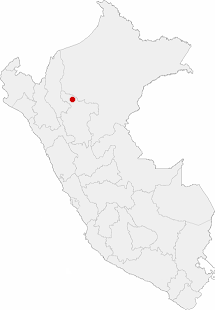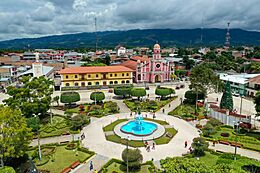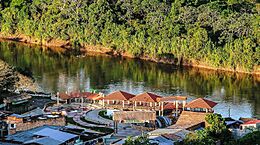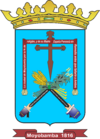Moyobamba facts for kids
Quick facts for kids
Moyobamba
Muyupampa
|
|||
|---|---|---|---|
|
From the top: Plaza de Armas, Punta de Tahuishco Stack, Liberty Square, Tahuishco Port, Moyobamba Cathedral
|
|||
|
|||
| Nickname(s):
Ciudad de las Orquídeas (City of Orchids)
Antigua Capital de Maynas (Ancient Capital of Maynas) Cuna de la cultura del oriente peruano (Cradle of the Peruvian Oriental culture) |
|||

Location of Moyobamba in Peru
|
|||
| Country | |||
| Region | San Martín | ||
| Province | Moyobamba | ||
| District | Moyobamba | ||
| Founded | July 25, 1540 | ||
| Founded by | Juan Pérez de Guevara | ||
| Area | |||
| • City | 2,129.86 km2 (822.34 sq mi) | ||
| Elevation | 860 m (2,820 ft) | ||
| Population
(2017)
|
|||
| • City | 50,073 | ||
| • Estimate
(2015)
|
56,452 | ||
| • Density | 23.51000/km2 (60.8906/sq mi) | ||
| • Urban | 56,452 | ||
| • Metro | 56,452 | ||
| Demonym(s) | Moyobambino/a | ||
| Time zone | UTC-5 (PET) | ||
Moyobamba is the capital city of the San Martín Region in northern Peru. It is sometimes called "The City of Orchids" because over 3,500 different types of orchids grow naturally in the area. About 50,073 people live in Moyobamba, according to the 2017 census.
The city is connected by roads to other important towns. These include Tarapoto to the southeast, Rioja to the west, and Bagua to the northwest. Roads also link Moyobamba to the Pacific coast.
Contents
History of Moyobamba
The first people to settle here were from the Chachapoyas culture. The modern city of Moyobamba was officially started by Juan Pérez de Guevara on July 25, 1540. He named it Santiago de los Ocho Valles de Moyobamba.
Early Beginnings
Moyobamba was built on the site of an old Inca settlement. It was the first city the Spanish founded in the Peruvian Amazon. It is also the second oldest Spanish town located east of the Andes mountains.
During the time of the Spanish Conquest, Moyobamba was a base. From here, Spanish explorers went into the surrounding areas.
Religious and Trade Center
The city was home to the first Christian missions in the region. The Roman Catholic Church used Moyobamba to teach Christianity to the native people. It became an important trading center during the colonial era, which lasted from 1533 to 1821. Moyobamba was officially given city status in 1857.
The historic "Puerto de Tahuishco" was once a busy port along the Mayo River. Today, it is one of the last remaining signs of the old river trade route.
Capital City Changes
On June 7, 1897, Moyobamba became the capital of the Loreto Region. Later, on September 4, 1906, it was made the capital of the San Martín Region. In 1948, it became the main seat for the Territorial Prelature of Moyobamba, which is a type of church area. On September 25, 2005, a strong earthquake affected Moyobamba.
Geography and Nature

The city of Moyobamba sits on a bluff (a high, steep bank) that looks over the Mayo River. It is about 2,820 feet (860 meters) above sea level. This area is known as the Ceja de selva, which is a humid, tropical region.
Amazing Orchids
The most famous plants in Moyobamba are the native Orchids. The city is known for having a huge number of different orchid species.
Natural Attractions
The area around Moyobamba is full of natural wonders. You can find rivers, caves, waterfalls, hot springs, and lakes. Some popular spots include:
- The Tioyacu River.
- The underground river inside the cave of the Huacharos (Cueva de los Huacharos).
- The natural hot springs at San Mateo.
- The beautiful Laguna Azul lake.
- The Ahuashiyacu waterfall.
- The Gera waterfall.
Climate
Moyobamba has a tropical climate. This means it is rainy, very warm, and humid, like a savanna. The temperature usually stays between 14°C (57°F) and 30°C (86°F). The average temperature throughout the year is about 22°C (72°F). Sometimes, it can get cooler at night in Moyobamba.
| Climate data for Moyobamba, elevation 879 m (2,884 ft), (1991–2020) | |||||||||||||
|---|---|---|---|---|---|---|---|---|---|---|---|---|---|
| Month | Jan | Feb | Mar | Apr | May | Jun | Jul | Aug | Sep | Oct | Nov | Dec | Year |
| Mean daily maximum °C (°F) | 27.9 (82.2) |
27.7 (81.9) |
28.0 (82.4) |
28.4 (83.1) |
28.6 (83.5) |
28.3 (82.9) |
28.5 (83.3) |
29.2 (84.6) |
29.4 (84.9) |
29.2 (84.6) |
29.2 (84.6) |
28.1 (82.6) |
28.5 (83.4) |
| Mean daily minimum °C (°F) | 19.1 (66.4) |
19.2 (66.6) |
19.2 (66.6) |
19.2 (66.6) |
18.9 (66.0) |
18.1 (64.6) |
17.4 (63.3) |
17.4 (63.3) |
18.0 (64.4) |
18.9 (66.0) |
19.4 (66.9) |
19.4 (66.9) |
18.7 (65.6) |
| Average precipitation mm (inches) | 131.0 (5.16) |
170.1 (6.70) |
178.0 (7.01) |
126.0 (4.96) |
97.8 (3.85) |
59.6 (2.35) |
53.6 (2.11) |
66.4 (2.61) |
90.0 (3.54) |
126.9 (5.00) |
126.1 (4.96) |
146.0 (5.75) |
1,371.5 (54) |
| Source: National Meteorology and Hydrology Service of Peru | |||||||||||||
People of Moyobamba
The people of Moyobamba come from many different backgrounds. This creates a rich mix of cultures. Most of the population, about 70 percent, has European roots, mainly from Spain and Italy. There are also smaller groups from places like Armenia, Syria, Germany, and Poland.
About 25 percent of the people are "mixed," meaning they have both Native American and European ancestors. The remaining 5 percent include people of Chinese, Japanese, Quechua, and other Native American groups from the Amazon. There are also people of African descent.
Economy
Moyobamba is a major center for farming. It is also an important trading hub for the Aguaruna Native Communities. These communities live in the surrounding Upper Mayo River Valley.
Main Crops and Products
The most important crops grown in the region are rice, coffee, and corn. Farmers also produce cotton, sugarcane, tobacco, and cocoa.
In the city, people make alcohol, liquor, wines, and straw hats.
Natural Resources
Nearby, you can find Hot springs, gold, and some petroleum (oil).
Moyobamba faces challenges in connecting with outside markets. This is because its airport became less active. This has caused the city to grow slower than its neighbor, Tarapoto. Sometimes, farmers and local government workers have disagreements about who controls the area and how to access markets.
Festivities
Fiesta de San Juan
The people of Moyobamba, called "Moyobambinos," celebrate their region's patron saint, San Juan (Saint John the Baptist), every year on June 24.
Locals celebrate with traditional dances and special dishes. The most famous dish is called Juane. It is made by stuffing sticky green rice with chicken and wrapping it in bijao (a type of leaf) for cooking. The dish is said to look like the head of John the Baptist on a platter.
During the celebration, people dance the "Pandilla" around wooden poles. These poles are dug into the ground. After dancing, they chop down the poles with an axe and collect any treasures placed at the top.
Sister cities
Moyobamba has "sister city" relationships with several other cities around the world. This means they share cultural and economic ties.
See also
 In Spanish: Moyobamba para niños
In Spanish: Moyobamba para niños








